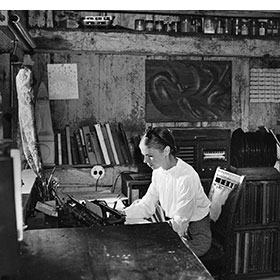ヴァージニア・リー・バートンが語りかけるもの
岡部三知代 公益財団法人ギャラリーエークワッド 副館長/主任学芸員
水色の表紙に描かれたデイジーのリース、その中で幸せそうにたたずむ赤い煙突屋根の『ちいさいおうち』。その下に、つる草の装飾のついた手描き文字での「ばあじにあ・りー・ばあとん・ぶんとえ」「いしいももこ・やく」と二人の女性の名前が記されていたことを覚えていらっしゃる方も多いと思います。子どもが最初に出会う本として読み継がれ、親から子へ、子から孫へと世代を超え、また人生において何度も出会う絵本『The Little House』、その作家がヴァージニア・リー・バートンです。

彼女は絵本作家としてだけでなく、テキスタイルやグラフィックの世界でも活躍しました。産業革命に湧くアメリカ社会の中で失われつつあった、手仕事や日常の生活の中から生まれる素朴なデザインを大切にしたい、とバートンが中心となって、ケープアン在住の家庭を持つ女性たちと共に立ち上げた手工芸の職人集団フォリーコーブ・デザイナーズは、当時一世を風靡していた雑誌『LIFE』(1945.11.26)などで紹介されると全米において話題となり、その作品は大手デパートや、展覧会で次々に称賛を浴びました。彼女が扱うデザインのモチーフは、身近な自然や日常の一コマ、一コマでした。デザインの才能は誰もが持っていること、そしてデザインのモチーフは、特別なことである必要はなく、日々の暮らしの中で起こる出来事や、風景の変化を良く観察し、本当に自分の心が動くものから探すというのが彼女の信念でした。彼女はデザイナーを育てるために、1:2:4の比率や、光と影のコントラスト、濃淡などのパターンを幾つもスタディするテキストを作成し(後に未完『DESIGN AND HOW!!!』草稿に繋がる)、分かり易く仲間にデザインを教えました。その課程を修了した者だけが、フォリーコーブのデザイナーとして認められました。デザイナーは、一年に一つ以上のデザインを完成させ、デザインから彫刻、プリントまでの全ての制作のプロセスを自分の手で行うことがルールでした。1941年から1968年までに、43人のデザイナーが生まれ、333のデザインを制作、販売しました。
彼女の生きた時代は、第二次世界大戦、世界恐慌とまさに激動の時代でもありました。戦争が終わると、高度経済成長期を迎えますが、1970年代のウーマンリブを前にして女性の社会進出への道はまだ開かれていませんでした。彼女は、フォリーコーブのデザイナーとして仕事をする傍らで、13冊の絵本を創作し、後に社会に進出する女性のパイオニアでもありました。家族の生活を守り子どもを育て、好きな仕事をすることは時に相容れないこともあります。全てを満足に成し遂げるには時間も足りません。でも、女性も、自分が自分の生き方を決め、仕事をしなければならないのです。絵本の中のおうちや、スチームショベルなどの主人公はいつも、たくましくて優しくて、頼りになる女性です。女性だって、何でも出来る、でも大切なのは仲間とのパートナーシップや家族だと…そして、今から女性の歴史が始まるのよ…と訴えているようです。
また彼女は、自分を取り囲む社会や環境は常に変容していくことを知っていました。変容する中でも、信念を曲げずに生きる道を切り拓き、より良い選択する力が必要だということを伝えたのです。
彼女はダンサーであり、デザイナーであり、画家であり、彫刻家でもあり、優れた指導者であり、母でもありました。女性は多くのことが出来ると、身を持ってしめしたのです。
絵本は子どもたちのために…、フォリーコーブ・デザイナーズは大人たちのために…彼女はいつでも彼女の創作した絵本の中にいて、私たちに語りかけています。人生の物語のハッピーエンドは自分の力でつくりなさいと…。

自宅離れの1階のバートンのアトリエにて
母家に隣接する納屋は、ヴァージニアのアトリエになり、
壁にはダンスをイメージした木彫の作品が飾られ、
その下にお気に入りのレコードをいくつもたてかけて音楽を聴き、
珈琲を飲みながら仕事をした。
Virginia Lee Burton’s Message
Michiyo OKABE Gallery A4 Deputy Center Director/Chief Curator
On the light blue cover of the book is the red roofed “little house” with a chimney standing happily surrounded by the wreath of daisies. Under the illustration is the hand written and vine decorated names of two women: Written and illustrated by Virginia Lee Burton and translated by Momoko Ishii. You may remember their names. The book has been read as the first book a child encounters and handed over from parents to children and then to grandchildren. “The Little House” is a book we read many times in our life. And the author of the book is Virginia Lee Burton.

Ms. Burton was active not only as a picture book writer but also as a textile and graphic designer. She valued naïve and pristine designs handmade in the ordinary daily life, which was to be lost in the industrial revolution of America. Ms. Burton played the central role in the art group Folly Cove Designers she founded with the other women in Cape Ann. Their activities were featured in the popular “LIFE” magazine(1945.11.26) and attracted people’s attention. Their works were highly appreciated when displayed at the major department stores and exhibitions. Motifs of her design were scenes of familiar nature and of our daily life. She strongly believed that the talent in design was in the everybody’s mind and in the eyes observing things in our daily life. She wrote students’ textbooks to teach 1:2:4 ratios, contrast of light and shadow and pattern of shades. (The textbook was further developed into her uncompleted book of “DESIGN AND HOW!!!”.) It is easy to understand for her fellow women students to learn. The students who completed the course were certified as Folly Cove Designers. It was the rule that the designers should create one or more designs a year and worked by themselves all through the production process from designing, linoleum cutting and printing. There were 43 designers who succeeded in the training between 1941 and 1968, producing and selling 333 designs.
She lived in the midst of turbulence of the Second World War and the global depression. After the war, the country entered the period of rapid economic growth. The society, however, was not open to women before the women's lib movement in 1970’s. Burton was a pioneer of woman advancing into society, working as Folly Cove Designers and publishing 13 picture books. It was sometimes not easy to take care of the family, raise the children and do the work she liked. There was not enough time to perform all these activities to satisfaction. Women had to decide how they would live and work. It was her intention that all the main characters of her picture books, including the house and the steam shovel, were women. Through her books, she sent the message to children that women can do whatever they like to do and what is critical is the partnership with their colleagues and families.
She also knew that the society and the environment around us were always changing. She told the readers it is important to open our way without loosing our belief and to make good decisions.
She was a dancer, designer, painter, sculptor, good leader and mother. She showed that women could wear many hats by her own action.
She created picture books for children and Folly Cove Designers for adults. She is always with us through her picture books, telling us, “You should create happy ending of your life story by yourself.”

In the atelier on the first floor of her detached house
The barn next to their house was made into her atelier.
She decorated it with wooden work of her dancing images.
She put her favorite records below the work and worked on
her creation, listening to music and having cups of coffee.